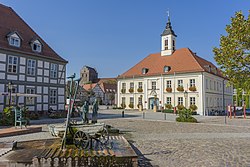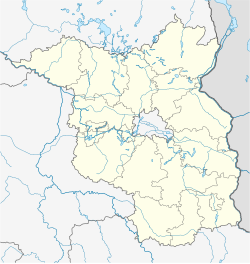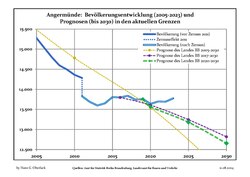world.wikisort.org - Germany
Angermünde (German pronunciation: [aŋɐˈmʏndə] (![]() listen)) is a town in the district of Uckermark in the state of Brandenburg, Germany. It is about 43 miles (69 km) northeast of Berlin, the capital of Germany.
listen)) is a town in the district of Uckermark in the state of Brandenburg, Germany. It is about 43 miles (69 km) northeast of Berlin, the capital of Germany.
Angermünde | |
|---|---|
Town | |
 Market Place & Townhall | |
 Coat of arms | |
Location of Angermünde within Uckermark district  | |
 Angermünde  Angermünde | |
| Coordinates: 53°02′0″N 14°00′0″E | |
| Country | Germany |
| State | Brandenburg |
| District | Uckermark |
| Subdivisions | 24 Ortsteile |
| Government | |
| • Mayor (2016–24) | Frederik Bewer[1] |
| Area | |
| • Total | 326.44 km2 (126.04 sq mi) |
| Elevation | 50 m (160 ft) |
| Population (2020-12-31)[2] | |
| • Total | 13,637 |
| • Density | 42/km2 (110/sq mi) |
| Time zone | UTC+01:00 (CET) |
| • Summer (DST) | UTC+02:00 (CEST) |
| Postal codes | 16278 |
| Dialling codes | 03331 |
| Vehicle registration | UM |
| Website | www.angermuende.de |
The population is about 14,000, but has been declining since its traditional industrial base, enamel-working, has declined. An administrative sub-centre of its district, it has several Protestant churches, a former Franciscan church, a number of schools of higher learning and a recently refurbished historic marketplace with an old town hall. Located in the game-filled forests of the Uckermark, with its many lakes, it now relies heavily on tourism and the sources of revenue linked to it.
Since 2010, Angermünde is a federally declared resort town.[3]
Name
The name Angermünde is an abbreviation of the older town of Tangermünde, for a while the town was named New-Tangermünde (Neu-Tangermünde), until it was changed to "Angermünde", with Anger being German for a central square in a town.
Geography
With an area of around 324 km2, Angermünde is Germany's 16th largest municipality.[4] It is located in the Uckermarck region, roughly 80 km north of Berlin. The community is made up of the Inner City (German: Kernstadt) and 23 adjacent districts: Altkünkendorf, Biesenbrow, Bölkendorf, Bruchhagen, Crussow, Dobberzin, Frauenhagen, Gellmersdorf, Görlsdorf, Greiffenberg, Günterberg, Herzsprung, Kerkow, Mürow, Neukünkendorf, Schmargendorf, Schmiedeberg, Steinhöfel, Stolpe, Welsow, Wilmersdorf, Wolletz, and Zuchenberg.
Additionally, there are 40 more registered neighborhoods within the districts (German: Wohnplätze): Altenhof, Augustenfelde, Ausbau, Ausbau Mürower Straße, Ausbau Pinnower Weg, Ausbau Welsower Weg, Bauernsee, Blumberger Mühle, Breitenteicher Mühle, Friedrichsfelde, Gehegemühle, Glambecker Mühle, Greiffenberg Siedlung, Grumsin, Henriettenhof, Klein Frauenhagen, Leistenhof, Leopoldsthal, Linde, Lindenhof, Louisenhof, Luisenthal, Mürow-Oberdorf, Neu-Günterberg, Neuhaus, Neuhof, Peetzig, Rosinthal, Schäferei, Sonnenhof, Sternfelde, Stolper Mühle, Thekenberg, Waldfried, Waldfrieden, Wilhelmsfelde, Wilhelmshof, Ziethenmühle und Zollende.
History
The town was the site of a 1420 victory of Frederick I of Brandenburg over the Pomeranians.[5]
In the 19th century, the town was the seat of a Prussian circle in the province of Brandenburg and linked to Berlin by the Berlin–Stettin (now Szczecin, Poland) railway.[6] Angermünde station then served as the junction for branch lines servicing Prenzlau, Bad Freienwalde, and Schwedt.[5]
Demography
 Development of population since 1875 within the current Boundaries (Blue Line: Population; Dotted Line: Comparison to Population development in Brandenburg state; Grey Background: Time of Nazi Germany; Red Background: Time of communist East Germany)
Development of population since 1875 within the current Boundaries (Blue Line: Population; Dotted Line: Comparison to Population development in Brandenburg state; Grey Background: Time of Nazi Germany; Red Background: Time of communist East Germany) Recent Population Development and Projections (Population Development before Census 2011 (blue line); Recent Population Development according to the Census in Germany in 2011 (blue bordered line); Official projections for 2005-2030 (yellow line); for 2017-2030 (scarlet line); for 2020-2030 (green line)
Recent Population Development and Projections (Population Development before Census 2011 (blue line); Recent Population Development according to the Census in Germany in 2011 (blue bordered line); Official projections for 2005-2030 (yellow line); for 2017-2030 (scarlet line); for 2020-2030 (green line)
|
|
|
Mayors
- 1989–1998: Wolf-Hugo Just
- 1998–2016: Wolfgang Krakow (SPD)
- since 2016: Frederik Bewer (independent)
Frederik Bewer was elected in May 2016 with 95.3% of the vote, for an eight-year term.[8]
Gallery
- City wall
- Touristinformation
- The lake Mündesee in Angermünde.
- Holy Spirit Chapel
- Timbered house
- City Church St. Mary
- Church in Schmiedeberg
- Alcove house in Schmiedeberg
- Alcove house in Schmiedeberg
- Fountain and sculptures by Christian Uhlig
Sons and daughters of the town

- Friedrich Heinrich von der Hagen (1780–1856), German scholar
- Albert Manthe (1847–1928), sculptor
- Hermann Dietrich (1856–1930), born in Schmargendorf, politician (DNVP), member of Reichstag
- Ehm Welk (1884–1966), writer
- Hans-Erich Voss (1897–1969), Vice Admiral in World War II
- Günter Reimann (1904–2005), economist and journalist
- Heinrich Borgmann (1912–1945), adjutant of Adolf Hitler
- Hartmut Losch (1943–1997), athlete, European champion in discus throw
- Maik Heydeck (born 1965), boxer
- Julia Jäger (born 1970), actress
Twin cities
- Eselkamp, North Rine-Westphalia
- Lüdge, North Rine-Westphalia
- Strzelce Krajeńskie, Lubusz Voivodeship, Poland
- Zurrieq, Malta
Notes
- Landkreis Uckermark Wahl der Bürgermeisterin / des Bürgermeisters, accessed 4 July 2021.
- "Bevölkerung im Land Brandenburg nach amtsfreien Gemeinden, Ämtern und Gemeinden 31. Dezember 2020". Amt für Statistik Berlin-Brandenburg (in German). June 2021.
- "Stadt Angermünde ist jetzt staatlich anerkannter Erholungsort". Niederlausitz Aktuell (in German). 2010-12-13. Retrieved 2022-02-04.
- "Gemeinden mit der größten Fläche in Deutschland". Statista (in German). Retrieved 2022-02-04.
- EB (1911).
- EB (1878).
- Detailed data sources are to be found in the Wikimedia Commons.Population Projection Brandenburg at Wikimedia Commons
- Ergebnis der Bürgermeisterstichwahl am 8. Mai 2016
References
- Baynes, T. S., ed. (1878), , Encyclopædia Britannica, vol. 2 (9th ed.), New York: Charles Scribner's Sons, p. 29
- Chisholm, Hugh, ed. (1911), , Encyclopædia Britannica, vol. 2 (11th ed.), Cambridge University Press, p. 8
External links
- Official Website (in German)
На других языках
[de] Angermünde
Angermünde ( Aussprache?/i) ist eine Kleinstadt im Landkreis Uckermark im Bundesland Brandenburg von Deutschland. Seit 2010 trägt sie das Prädikat staatlich anerkannter Erholungsort.[2][3]- [en] Angermünde
[es] Angermünde
Angermünde (AFI:aŋɐˈmʏndə) es un pueblo en Alemania, en el estado de Brandeburgo, en el distrito de Uckermark a 69 kilómetros de Berlín.[ru] Ангермюнде
Ангермюнде (нем. Angermünde) — город в Германии, в земле Бранденбург. Входит в состав района Уккермарк. Официальный код — 12 0 73 008.Другой контент может иметь иную лицензию. Перед использованием материалов сайта WikiSort.org внимательно изучите правила лицензирования конкретных элементов наполнения сайта.
WikiSort.org - проект по пересортировке и дополнению контента Википедии
















